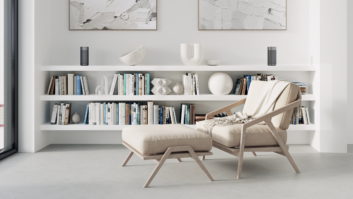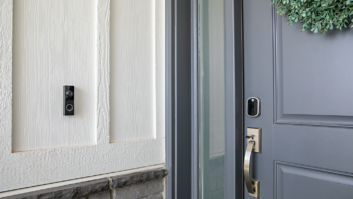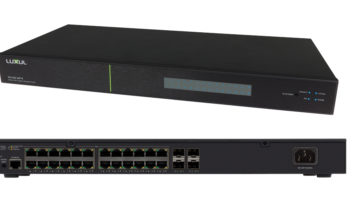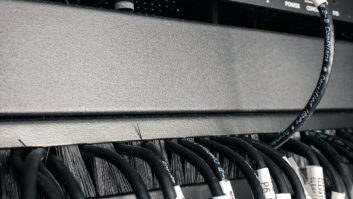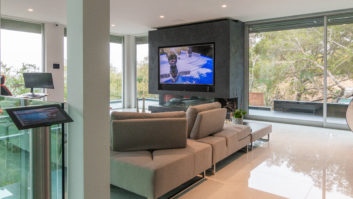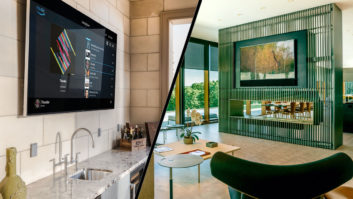The idea behind my Control4 home installation started out with no actual Control4 gear in the mix at all.
I generally try to work with what I’ve got, tech-wise, unless a change is completely necessary (something stops working). But with so many devices competing for bandwidth, my network really wasn’t cutting it anymore as the backbone of the home.
I considered Pakedge to be one of those “industry standard” companies that could help bring my network up to snuff, so initially I started chatting with RS blogger Todd Puma for advice. Then, when Control4 acquired the network technology company last year, the opportunity to expand the technology in my Carmel, IN, home with an improved network AND integrated home system came along.
Going in, my 25-year-old house already had a hodgepodge of AV gear, much of which I didn’t want to remove. Only my network and main TV control system were really ailing, so I thought I’d cherry pick a bit to pick out the best Control4 gear to round out the install.
Ultimately, I committed to a Control4 System Remote Control (SR260) and EA-1 Entertainment and Automation Controller for the family room AV controller, a Control4 Wireless Thermostat by Aprilaire to give me my first experience with app-based HVAC control, a Kwikset door lock for the back door to my garage (a little touch of cloud-based security integration), and four rooms of dimmers to round out my existing entry-level Lutron AuroRA lighting control system. It would remain a rather kludged-together system, but I was a little shy about committing to a full-scale replacement of a lighting control system that my family was comfortable with.

Andy Bang (left) and Bill Lehman of Millennium SoundsInitially, Puma offered to help design the system and walk me through the install remotely, but I soon realized that taking Control4’s offer to hire an Indianapolis-based integrator, Millennium Sounds, was the wiser path. Gone was the goal of gaining a hands-on installation experience, but gone also was the potential for more headaches for me as a novice installer. And, for the first time, I would see custom integrators on the job in my own home. It would literally be a “luxury” for me to be “the client” of Millennium Sounds owner Bill Lehman, his lead tech Andy Bang, and their subcontractors.
After an initial visit from Lehman, I knew I was in good hands. His personable nature and professionalism put me at ease. Yet, the first time you open the door on installation day, you know that anything can happen. There’s that worry in the back of our mind you may lose your internet connection for an extended period of time or that your family won’t be able to watch TV at the end of the day. I hate to sound spoiled, but these are the creature comforts that we get used to, and I work from a home office, making connectivity essential.
Installation day started with Millennium Sounds’ HVAC subcontractor, The Edge Guys, assessing my home’s setup and asking me a question about my year-old comfort control system that I didn’t know the answer to. Fortunately, the contractor was really just being polite, and answered his own question as soon as he entered our utility room. It was noteworthy that Lehman had the wisdom to bring in a specialist to what I viewed as one of the more straightforward elements of the systems: the thermostat. But clearly, there’s much more to that technology than meets the eye. Later, Bang told me that Millennium Sounds had learned the hard way that they couldn’t be experts in everything, and that subcontracting was the best approach when it came to HVAC.
“We had that 2 a.m. panic call: ‘My heat won’t come on,’ about six months after an install, and right after the summer had ended,” Bang recalled. “And we had to get someone out there quickly to fix the system. Typically it’s because they have some sort of secondary heat pump or something that we didn’t know about. There are too many different scenarios and too many types of heating and cooling systems. It’s not just four or five wires that all hook up the same way. If you’re not an expert in HVAC, then it’s better to just hire a sub.”
Lehman and Bang arrived next, along with an electrician, hired from Kinder Electric to install my dimmers.

Bathroom Dimmer SwitchI’ve been installing my own dimmers forever, so that process also seems fairly routine at this point. But having it done by a professional was so much better, because I didn’t have to deal with the challenges of three-way switches or struggle to snip and bend unruly Romex wire behind the switch plate. The electrician, Adam, had a good sense of humor too, flip-flopping my laundry room exhaust wall switch with the room’s light switch dimmer, so I didn’t have to “live like a barbarian,” anymore by accidentally flipping on the fan when I really wanted to turn on the light.
I had installed the door lock myself months earlier, first as the ZigBee-enabled but non-Control4 version, then later with the Control4 chip inside. That meant that Bang simply had to drop the driver into his program, tap a button like he does for any other ZigBee device, and load it into the project. My family has already learned the default code for the lock, so Bang didn’t make any changes in that regard, and I didn’t ask for any special “Away” button to be added to the program (though he could have accommodated that request through Composer programming). My 4Sight subscription allows me to lock and unlock my door remotely and receive status from my phone via the Control4 app.
Living with the system since December, I’ve had a long time to experience the system and assess my likes and dislikes. Even though I thought that the network would mean the most to me, I’m really no different from most end users out there in that the user interface for the TV is really what I like the most. Having a remote that just works, almost every time you push a button is a huge improvement. I’ve had professional-quality remotes in the past, but this one seems much less prone to user error. The SR260’s button design is slightly different than I’m used to (sometimes, when fast-forwarding through a recorded commercial, I’ll accidentally click the DVR button instead of the Play button), but otherwise the ergonomics are good, the battery life seems long enough, and IR blasting does its thing connecting to the IR bugs on my Uverse set-top box, Blu-ray player, Apple TV, and ancient plasma TV, as well as to the RS-232 trigger on my AV receiver. And, for the first time, I’m able to properly switch from cable to Apple TV, to Blu-ray, to Wii, to Nuvo Renovia music system, without special instructions for family members or babysitters.
The initial installation lasted only one day, with no noticeable hiccups during the process. “One of the big advantages of Control4 is having drivers for many devices making programming integrator friendly without the need for extensive custom programming for basic functionality. You only need to do small amounts in every job to get the required functionality,” Bang said after the install. “You stick all of the devices in, make your connections, make sure the drivers are appropriate for the devices they’re supposed to control, position the IR bug over the emitter, and then you should have basic functionality. Then you go through and test your basic functionality and if there’s something that isn’t working right, you do a little custom programming to make it function correctly. If there’s something the customer wants specifically, such as a macro based on a button press or a double tap on the light switch to accomplish an automation task, you would then go into the custom side of Control 4 programming to make this a reality.”

Control4 RemoteI’ve heard the debate over the years about the benefits of custom UIs versus standardized home automation technologies, and although the scrolling “source menu” at the top of Control4’s remote is custom-ish, the remote is basically locked down, from a design standpoint. My experience so far is that this approach is preferable to the more customized approach. It shortens the end-user learning curve, speeds up programming, and probably reduces user errors.
“With Control4 you can go super simple, with a single-room remote or some light switches, to completely wild where you integrate all TVs, audio, lighting, security systems, and HVAC with custom programming to get the customer’s desired effect,” Bang said. “There’s a whole slew of customization options with Control4.”
Millennium Sounds sells Control4 almost exclusively for home projects, while it turns to Crestron on certain commercial installations for its customized UIs. They limit the use of Crestron in a residential installation because of budgetary constraints in the project.
Bang said that Control4 isn’t limited to smaller residential projects, however. “We’ve done Control4 with fully distributed and automated audio-video coupled with full-house panelized lighting in large home projects,” he said. “Control4 is great if it’s one room or 50 rooms. It works very well, is relatively easy to set up, infinitely customizable, provides a great end-user experience, and it’s priced right.”
So, after the rock-solid performance of the Control4 remote control, I’d have to point to the Pakedge network as the second most notable addition to my home. When I chatted with Bang weeks after the install, I told him how hard it is to quantify the performance of a network. Running a download/upload speed test has more to do with the quality of your ISP’s services and how much money you’re spending on data speed. Dropped programming on Apple TV might just be a problem with that particular device, in particular right before a firmware update is due.
Connected to my AT&T modem, Millennium Sounds installed a RE-2 router with an SX-24P16 switch and one of two WK-2 WAPs in my main network equipment stack. Plus, an SE-8P switch in my entertainment equipment cabinet with the second WK-2 WAP.
The networking improvement that I can clearly report is consistent Wi-Fi signal strength throughout my home. I now have two WAPs instead of one, so I no longer have a dead spot on one end of the house, and the upstairs and basement areas of the house are getting four bars for the first time. Most devices are hardwired to Ethernet, but on our mobile devices, streaming video is much steadier. And most important of all, I now know how to troubleshoot a problem when I have one. I have faith that the network is probably the last in a list of possible culprits, if I’m having a streaming problem.
Just for fun, Control4 also included a motion sensor in my equipment package, suggesting that I have it connected to a bathroom light. Instead, I had Bang add it to my laundry room/garage entry space. Surprisingly, it has been one of my favorite Control4 additions. In a room through which so much foot traffic flows, it’s great to have the light turn on automatically, and back off two minutes after exiting.

Control4 six button panel replaces Lutron controlsAfter a couple weeks of my initial trial run, I became fully committed to Control4’s lighting solution and decided it was time to expand the lighting control plan house wide, replacing my treasured AuroRA system. I was concerned that my family would miss the simplicity of tabletop “all-off” and a single “preset on” button from the Lutron system, but Bang reminded me that we could install multi-button switches at strategic locations throughout the house for those and additional scenes.
So Bang returned to my house for another walkthrough, we ordered the switches we would need to round out the system, and electricians Adam and his colleague Avery returned a few weeks later to get started. Andy joined them a couple of hours into the process, so he could begin programming, and by 2:00 p.m., the electricians were gone and Andy and I were walking through the scenes.
Andy had built and named the scenes according to my best theory on how I would like to use the lighting control. For my six-button keypad at the front and garage entrance to the house, as well as outside my master bedroom, we assigned the following scenes: Day, Night, Away, Working [for when I’m working in my home office on a cloudy day], Path [for limited lighting from upstairs bedrooms to the kitchen], and All Off. The day after Andy left, I tweaked the lighting percentages for each scene, and I’ve been happy with the system ever since.
While my family and I were away for Spring break, I used the Vacation setting on the HVAC system, and then checked in on the house-wide temperature from my iPhone from time to time, seeing the temp drop as the outside weather remained chilly. On our drive home, I switched the system back to the Comfort setting and everything was normal when we walked in the door.
The Away scene for my lighting control system also allowed me to leave a few select “security” lights on without draining our energy bill while we were gone.
Another couple of surprise features that I’ve enjoyed so are the multi-button ceiling fan switch for my home office, which is also app-controllable, and Amazon Alexa integration. The fan switch replaces an ancient rotary knob, and I like it because I always know what fan setting I’m on, rather than needing to crank the dimmer knob all the way in one direction to figure it out. I’ve had Alexa integration at a smaller scale (two Lutron lamp dimmers and one wall dimmer) but now I’m able to control house-wide lighting, dimming individual lights to my liking or switching to one of my six scenes via voice. It’s an extra convenience that I don’t need to use every day, but it’s nice to have the option.
In fact, many of these features I’ve just described are little “tricks” of home automation that are nice to have but not why I signed up for an integrated system. When it comes down to it, I just wanted an intuitive and elegant way to control the lights in my home and to reduce headaches for my TV remote. Oh, and a network that does what it’s supposed to do, reliably. Control4/Pakedge and my trusted advisors from Millennium Sounds met the challenge of adding this type of technology to my home without adding new hassles. The process gave me a great insight into right way to do things in our industry.
